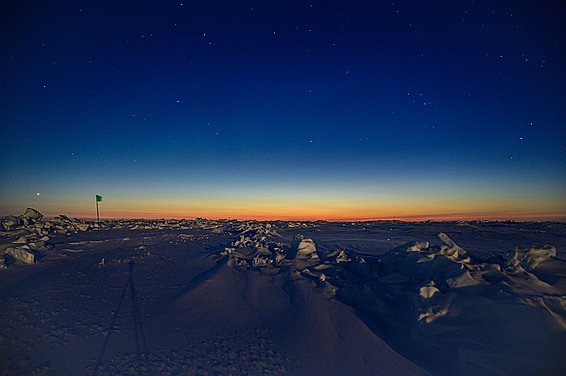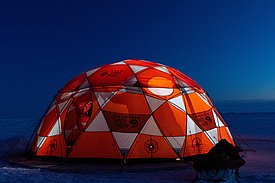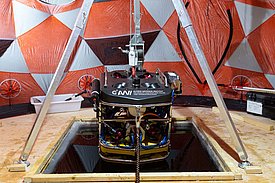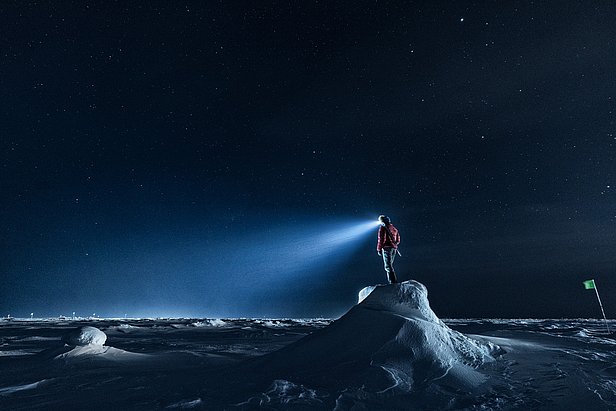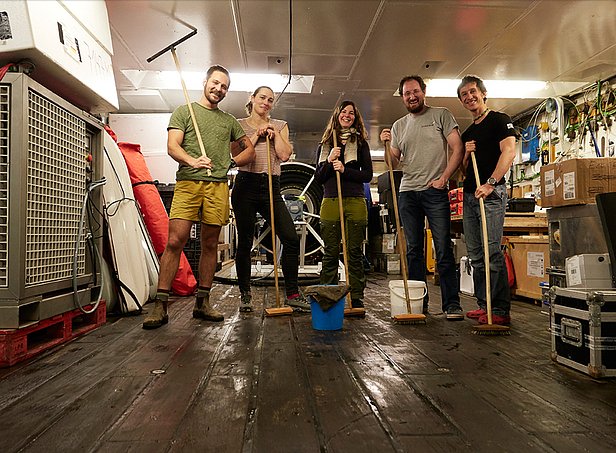26.02.2020 | Logbuch
[Translate to Englisch:] Autor ¶
The second leg of the MOSAiC expedition is drawing to a close: important measurements have been taken and the light is slowly returning.
Hooray! The horizon begins to glow for the first time in ages. Is it our imagination or can we make out the tiniest glimmers of long-awaited colour in the darkness? The light is returning, very very slowly. The temperatures are currently between -25 and ‑34 degrees. In late January, we had a day off work because of a storm, which brought wind speeds of up to 25 m/s and wind chill temperatures below ‑65 degrees. The captain wisely decided not to let us researchers venture out in such conditions. Apart from the risk of almost immediate frostbite, the storm also made the ice unsafe, opening up a number of cracks and crevasses.
Ice landscape from above and below
In spite of this, we've been able to collect plenty of data over the past two weeks. This is probably the first time in human history that high-resolution datasets of surface and underwater topography are being combined. We are measuring the surface topography of the ice with a resolution in the centimetre range using a terrestrial laser scanner (TLS), over a radius of up to one kilometre around the ship. To expand our observation radius even further, airborne laser scanner (ALS) measurements are also being taken from the helicopter. These cover a wider area but have a lower resolution.
The underwater beast
The underwater topographical measurements are performed by the 'Beast' – that's the name of the underwater robot. Combining both measurement methods provides a detailed description of the full extent of the ice sheet. Ice thickness distribution can also be determined from satellite images, but before we can begin to interpret those images we have to measure what's actually on the ground, at least once. With the current warming of the Arctic and the associated changing relationship between first-year and multi-year ice, the time has come to, as it were, 'recalibrate' the satellite images. These measurements are therefore important.
Dreaming of fresh rocket
During the Beast measurements, it's only the bear guard who suffers. The other three team members are nice and snug in the heated tent above the ice hole. The first thing to be done is a full functional test of the robot. If everything is working properly, the heavy part is lowered into the water using a pulley and approximately 700 m of cable is unrolled so that the pilot can follow the predefined routes and record the topography of the underside of the ice. For these two hours, we're free to daydream, bite into an imaginary chicory, imagine the taste of fresh rocket...and then be startled by a seal that suddenly peeps out of the ice hole (no doubt the seal is startled too!).
Set up, measure, dismantle, move on...
The TLS measurements are somewhat less comfortable as we're out in the open air all day. The reflectors, scanner, stand and generator are packed on a sledge. For the measurements, we work in pairs with one person sitting on the sledge and the other one driving. First we drive around the edge of the field to be scanned and distribute the reflectors. We then take measurements from eight to ten different positions using the scanner. This entails driving to a position, setting up the stand, hauling the 12 kg scanner onto the stand, tightening the retaining screw, connecting the scanner to the generator with a cable, switching on the laptop, plugging in the USB Logitech mouse using an ultra-rigid cable, starting up the software and taking the measurements. The all-round scan takes 14 minutes, during which you can relax a little, enjoy the starry sky or sit on the ground and listen to music on the laptop. It is highly repetitive work: set up, measure, dismantle, move on, set up, measure, dismantle, move on... And it isn't the only thing that's repetitive. The TLS day is always sausage and soup day – and sausage and soup always means the end of another week.
Replacement team delayed
Talking about the end... It's hard to believe, but true: the last scheduled week of leg 2 of the expedition is upon us. The team that will replace us set sail on 28 January aboard the icebreaker Dranitsyn, but charting its daily progress is a sobering experience. Sometimes it feels as though we, on board the Polarstern, are drifting faster towards the North Pole than the Dranitsyn can follow us. So here's my prediction: the Dranitsyn will arrive late and without enough fuel for the return trip, we'll then sail until the fuel line starts to gurgle, at which point we'll be refuelled by another icebreaker and reach Tromsø later than planned. Meaning we won't be back home until - sometime...
MOSAiC expedition live: https://follow.mosaic-expedition.org/

